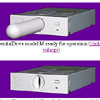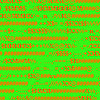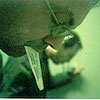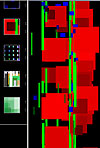 Note:
non-english
reviews
are
not
edited.
Note:
non-english
reviews
are
not
edited.Originally published 06/11/03
Le semaine prochain Professor Alexei Shulgin va presente un cours a Ensba (Ecole Nationale Superieure de Beaux Arts) Paris, France sur le theme de "Art en réseau et production d'une rencontre en temps réel" en colaboration de "le Studio de recherche temps réel piloté par Dominique Blais à l'Ensapc, le Collége Invisible avec Paul Devautour, et l'Université Pirate, un projet de Vincent + Féria".
Alexei Shulgin, responsible pour de projects divers comme "Form Art", "FuckU-FuckMe" et "runme.org" est un artiste tres connu a tous qui est active dans le cadre de net.art et cette rencontre gratuit et ouvert a tout est PAS POSSIBLE A MANQUE si vous ete en
Pour plus de renseignements et pour enregistre votre inscription email - contreconference@free.fr
:: Garrett Lynch
 Originally
published
on
06/05/03
Originally
published
on
06/05/03For those who like their HTML *completely* dynamic, there's YAST (Yet Another Sizing Tool), a Python/Zope artware page completely dependent on its users for content. Users upload or link images and text to the page and voila!--YAST collages this input together, forming a disjunctive jambalaya of images, text and links from its own audience. The contents of YAST are cleaned every so often, and the archived YAST state is emailed randomly to net-art museums that users suggest via the site.
YAST is a project by vnatrc.net, and is part of this year' s readme festival (2.3), run by runme.org.
For me, a project like YAST is what net art is all about. It resists the trend of subsuming web-based works under the rubric of cinema by actively *using* the network to manifest itself. It can't be reproduced anywhere else other than the network and depends on user-interaction for its manifestation. The only drawback to the piece is that, after a while, it begins to have the look and feel of a screensaver; and, divorced from its network roots, it would be.
:: Lewis LaCook ::
 Originally
published
June
06/06/03
Originally
published
June
06/06/03Here's an essential addition (at least in my eyes) to Eduardo Navas's article about mailing lists from last Wednesday [BumpList].
When I hear spam and mailing lists, I immediately think of Fredric Madre and Palais-Tokyo. The last was a totally unmoderated list (sometimes also called "Spammers Paradise") by the first. One of the "side effects" of this list was the rise of the spam engine (especially amongst French net artists). A very insightful text about this subject was written by Jean Philip Halgand called "After The Storm : about Spam Art and related practices ?la fran?ise". Furthermore the interview Josephine Bosma did with Fredric Madre is a must read for anybody interested in issues like spam and mailing lists.
:: Peter Luining ::
 Triple
Header
review:
Triple
Header
review:[1] Originally published on 06/11/03
French net artist b-l-u-e-s-c-r-e-e-n became famous with his project "netartconnexxion", a copy of Rhizome's art base that was put online the same day as Rhizome became a pay website. His latest project is ipPainting. This work consists of an ever-changing image based on the visitors IP address. For an extensive explanation of the whole project, visit the project's URL (click on the link above).
:: Peter Luining ::
[2] Originally published on 06/04/03
ipPainting, a project by b-l-u-e-s-c-r-e-e-n.net, whom we have reviewed before, is a work using designed compositions of code.
The artists have designed compositions or scripts formulated to certain rules, much like the paintings of Mondrian, Malevich or Kandinsky. Scripts are composed to a grid structure or only four-sided shapes of aesthetically pleasing colors. Each script is activated on the site for a certain period of time, allowing users to visit the composition and allowing the composition to register the users IP address as a contribution to its evolution. The numerical values of each IP are used (depending on the composition) to interpret the positions, forms or colors to be used, allowing the composed work to be both a net painting dispersed in time and virtual space and a collective unconscious work.
I feel, as an art work, this piece contextualizes itself extremely well, but in regards to classical art (i.e. painting) not new media or net art. It references where painting has been in the last century, how it's progressed and proposes one solution or escape root to what is fast becoming an art form that's simply folding in on itself. To call it painting using new media is just; and as Lev Manovich would note, painting that uses a database--the most significant new media form. To call it net art possibly misses the mark.
:: Garrett Lynch ::
[3]Originally publshed 05/03/03
And now, abstract expressionism is appropriated by net art!
b-l-u-e-s-c-r-e-e-n is at it again with Painting. This net project offers users a way to be creative by simply clicking! Yes, all you have to do is click and automatically contributes your IP address. The result is a set of abstract images that constantly change according to the number of people accessing the web page.
A rather interesting take on high modernism's theories of looking and appreciating art for its formal qualities, Painting is actually able to deconstruct the suspension of politics that many modernist theorists made popular around the middle of the 20th Century (especially Greenberg). Even though Painting may present abstract images as the end result, its dependence on the net-art community for contributions makes obvious the importance of communication, not only for aesthetics but also for the politicization of aesthetics as a power trope.
:: Eduardo Navas ::